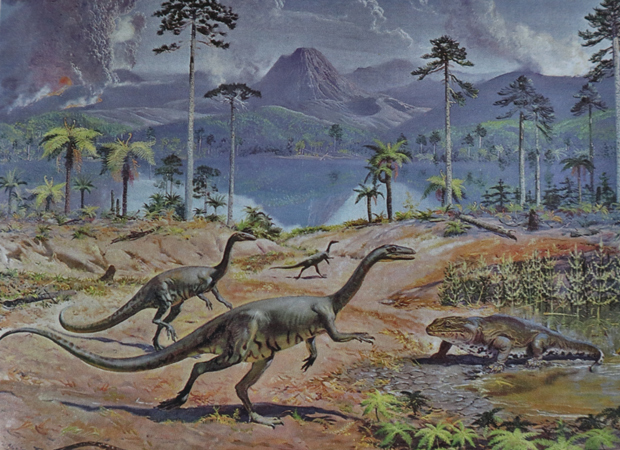Three-toed Dinosaur Track Found in South Wales
There has been a lot of media interest in the discovery of a beautifully-preserved three-toed dinosaur footprint on a beach near the town of Barry in South Wales. The track identified as an example of the ichnogenus Grallator was spotted by four-year-old Lily Wilder whilst out for a walk with her family. The specimen, preserved in a loose boulder is now in the care of scientists at the National Museum of Wales.
A Superb Example of a Three-toed Dinosaur Track from the Mercia Mudstone Group at Bendrick Rock (Vale of Glamorgan, South Wales)
Picture credit: National Museum Wales
An Area Famed for its Dinosaur Footprints
This part of the South Wales coast is famous for its prehistoric animal tracks, which represent the oldest confirmed dinosaur trackways known from the British Isles. The tracks are preserved in sediments associated with the Mercia Mudstone Group at Bendrick Rock and hundreds of individual prints have been found, representing at least sixty different trackways. National Museum of Wales Palaeontology curator Cindy Howells was notified of the find and has described it as the best specimen ever found on this beach. The print representing a small theropod dinosaur is estimated to be around 220 million years old (Late Triassic).
The print is a fraction over 10 cm long and was probably made by a light, agile, bipedal dinosaur similar in appearance to Coelophysis.
A Late Triassic Landscape Featuring a Trio of Coelophysis Dinosaurs

Beautiful and evocative artwork from Burian (Coelophysis bauri and Eupelor durus). An illustration of a Late Triassic scene featuring the small, agile biped Coelophysis (C. bauri).
Picture credit: Zdeněk Burian
The tracks preserved in the rocks exposed in this area not only record the movements of dinosaurs but prints associated with rauisuchian reptiles (crocodile-like contemporaries of the first dinosaurs), have also been found.
A Site of Special Scientific Interest (SSSI)
Like many similar sites in the UK, this part of the coast close to the seaside town of Barry is designated as a Site of Special Scientific Interest (SSSI). The landowner, the British Institute for Geological Conservation, is a charity that works to conserve natural heritage through site ownership, education and community engagement. Natural Resources Wales (NRW) had to seek special permission in order to remove the track. Researchers at the National Museum of Wales located in Cardiff will be studying the print in a bid to find out more about early dinosaur locomotion.
Commenting on this fantastic fossil find, Cindy Howells, the curator of palaeontology at National Museum Wales exclaimed:
“This fossilised dinosaur footprint from 220 million years ago is one of the best-preserved examples from anywhere in the UK and will really aid palaeontologists to get a better idea about how these early dinosaurs walked. Its acquisition by the museum is mainly thanks to Lily and her family who first spotted it. During the Covid pandemic scientists from Amgueddfa Cymru [National Museum Wales] have been highlighting the importance of nature on people’s doorstep and this is a perfect example of this. Obviously, we don’t all have dinosaur footprints on our doorstep but there is wealth of nature local to you if you take the time to really look close enough.”
Lily’s mother Sally Wilder stated:
“It was Lily and Richard (her father) who discovered the footprint. Lily saw it when they were walking along and said “Daddy look”. When Richard came home and showed me the photograph, I thought it looked amazing. Richard thought it was too good to be true. I was put in touch with experts who took it from there. We were thrilled to find out it really was a dinosaur footprint and I am happy that it will be taken to the national museum where it can be enjoyed and studied for generations.”
Dinosaur Tracks from the Vale of Glamorgan Area (South Wales)
Picture credit: Tom Sharpe (Dinosaurs of the British Isles)
To read a related article from 2012 reporting on the theft of dinosaur tracks from the Vale of Glamorgan: Dinosaur Footprints Stolen from the Vale of Glamorgan.
Everything Dinosaur acknowledges the assistance of a media release from National Museum Wales in the compilation of this article.
Visit the Everything Dinosaur website: Everything Dinosaur.








Leave A Comment